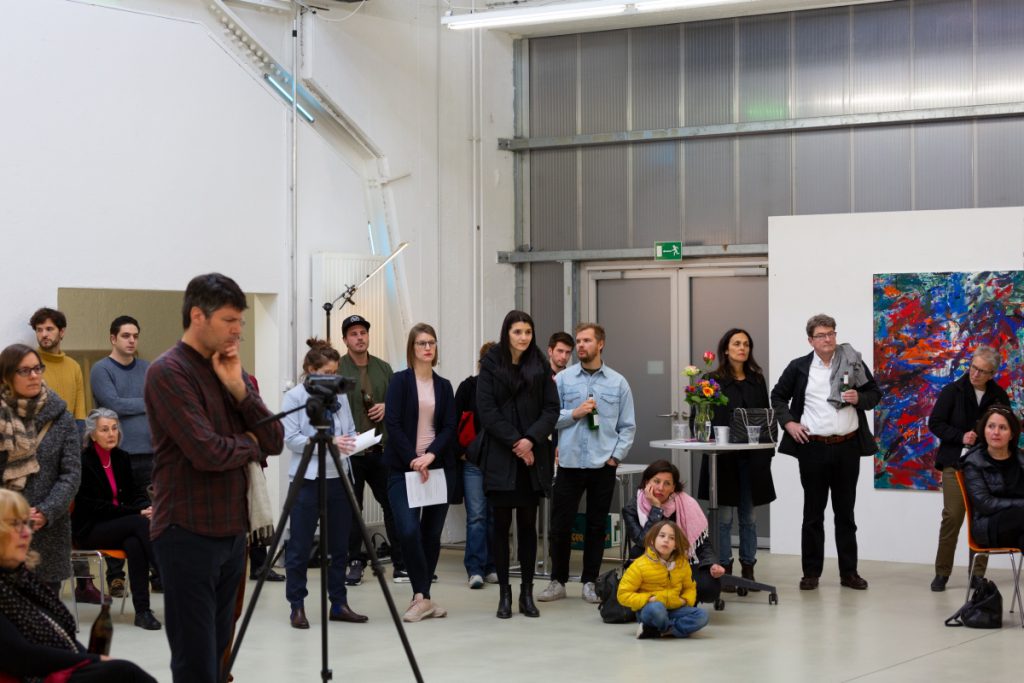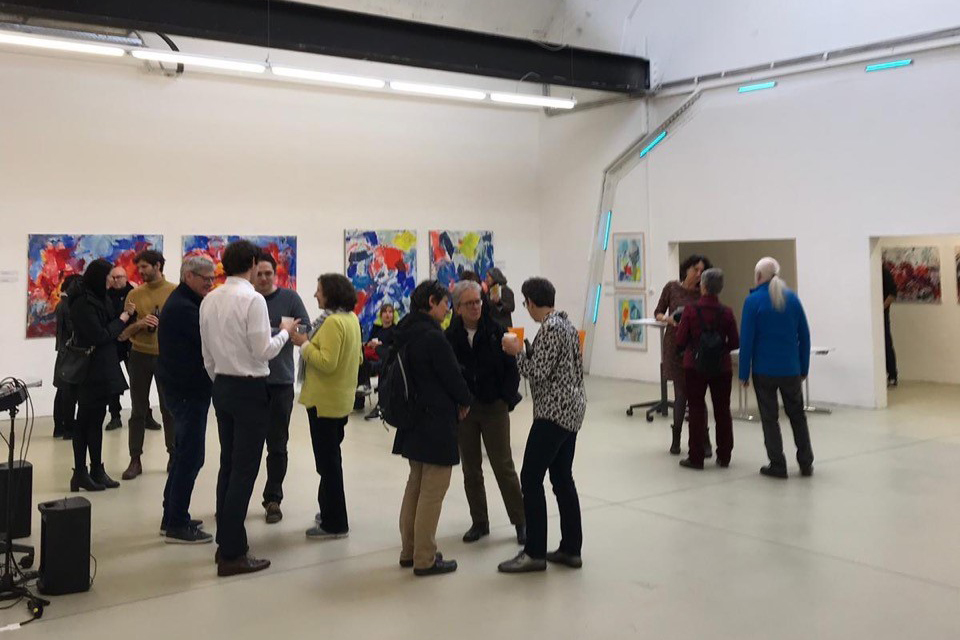Painting. Acrylic on canvas and paper
03/21/2019 to 03/31/2019
Domagkateliers, Halle 50, Margarete Schütte-Lihotzky Str. 30, 80807 München



The stage of the image
by Pravu Mazumdar
Text for the opening of the exhibition – Give it a splash -.
1. It is obvious that one has to open one’s eyes before looking at a picture. But before that – still with closed eyes – one has to fulfill another task. One has to encircle and for the time being eliminate the clichés that are already lurking in the forecourt of perception. These are prejudices and expectations that include art historical categories such as expressionism or biographical pigeonholes such as painting actress. But once one has opened one’s eyes and perceived the picture, the third task presents itself: one has to admit the part of the clichés that has been confirmed by the gaze.
2. Form and power are not opposites, but rather different and distinguishable positions on a scale of increases. Fo “the beautiful,” says Rilke, “is nothing but the beginning of the terrible, which we still just endure … because it calmly disdains to destroy us.” In the distance, a waterfall appears as form and image, but in the near distance, it appears as force that can crush us without any hesitation. Form and force correspond to different and incompatible views of the same object.
3. The dancing body draws shapes on the floor with its feet. With a brush in his hand he can draw different shapes: on a wall, on a canvas, on several canvases. But what happens first? Is the movement first and then the form? Or first a choreographic vision and then the movement and then the form? Or are movement and form triggered by a force like music? Or is every reality a kind of generalized music that acts on us and moves our feet and possibly a brush? Thus the painting appears as the end point of a concatenation of interlocking elements such as world, body, movement, form. The painting is no longer an imitation of the real, but a translation. It documents that the lines of force of the real have been broken in the sensorimotor medium of the body.
4. The point of departure for Carola von Seher-Thoss’s works is sometimes the free and distant nature that lies spread out before one with its presence and power to shake, for instance as a flaming red rocky landscape or as the surging water masses of a distant ocean or as the sprawling green of a redwood forest. Later, with the help of a photograph, the visual, aural, tactile, olfactory stimuli of the original encounter can be revived: as flashes of sensuality that penetrate the painting body and become large, vibrating movements that finally settle as brushstrokes on large canvases propped against the studio walls.
5. Thus, external nature often appears as the first image, passing through the camera eye and producing effects that penetrate the body and articulate as dance and movement, the movement of the painting hand, above all, that guides the brush and, carried by the dance, produces the second image, which emerges as a set of two or three large canvases masked by powerful brushstrokes, until the wave-like movement of the body, of the hand, of the brushstrokes vibrates out on a series of smaller sheets of paper, to germinate again after the wave’s turn of breath, to grow and leave new brushstrokes on the painting supports. Thus we have a cyclical concatenation of effects and transformations: Nature causes the photographic image, which imbues the body with effects and sets it in motion, which triggers the brushstrokes and in the end produces an image once again.
At times, however, the process of becoming a picture can also be triggered by a mood image deeply anchored in the soul, which gradually reveals the features of an inner landscape, in which, for example, a narrow path leads through dense undergrowth and gradually loses itself in the greenery. Often such dream images can be recognized in the encounter with real landscapes, which then lead to the brushstrokes via photography and dance.
6. Thus the space in front of the empty canvases is transformed into a strange stage on which the dance of painting can arise and spill away in several waves over the erected canvases. Once this initial movement has calmed down, the painter retreats to a distance from which her resting gaze can take in the still swarming brushstrokes that have just been created, her body once again starts to move, approaches the canvases again, and causes a renewed cloudburst of brushstrokes directly over the surface of the painting support. Gradually, the paintings are brought to completion in a cycle of stillness and movement.
At some point, in an unforeseeable future, a viewer will stand in the vestibule of the painting and allow another kind of movement to germinate within.
Pravu Mazumdar, essayist, cultural theorist studied physics in New Delhi and Munich and holds a PhD in philosophy from the University of Stuttgart. He writes in German and English. In his books, he creates diagnoses of modernity based on themes such as migration or consumerism, often drawing on the ideas of authors such as Michel Foucault and Walter Benjamin. In many of his essays he deals with contemporary jewelry, which he treats as a material expression of modernity.
He published among others; Das Niemandsland der Kulturen (Berlin: 2011); Gold und Geist: Prolegomena zu einer Philosophie des Schmuck (Berlin: 2015); “Against Criticism” (Parts I and II) in Art Jewelry Forum (Criticality series 6 and 7):